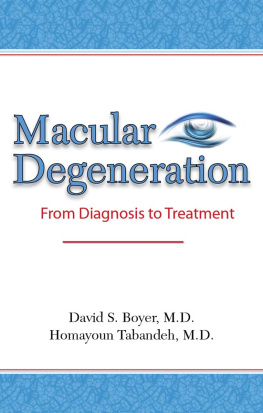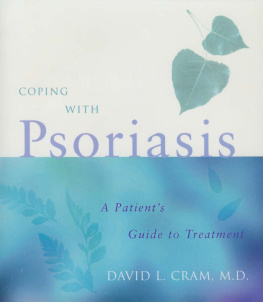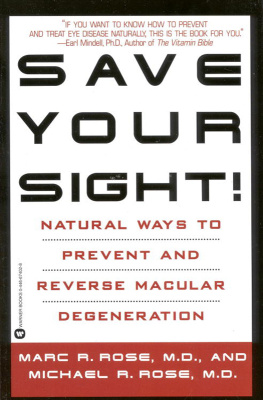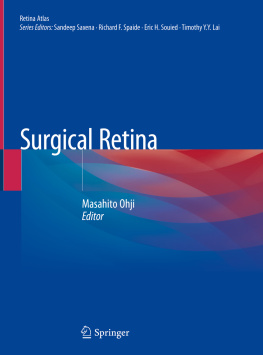An Addicus Nonfiction Book
Copyright 2012 by David S. Boyer, M.D., and Homayoun Tabandeh, M.D. All rights reserved. No part of this publication may be reproduced, stored in a retrieval system, or transmitted in any form or by any means, electronic, mechanical, photocopied, recorded, or otherwise, without the prior written permission of the publisher. For information, write Addicus Books, Inc., P.O. Box 45327, Omaha, Nebraska 68145.
ISBN 978-1-936374-32-8
Design by Jack Kusler
Illustrations by Jack Kusler
This book is not intended to be a substitute for a physician, nor do the authors intend to give advice contrary to that of an attending physician.
Library of Congress Cataloging-in-Publication Data
Boyer, David, 1947
Macular degeneration : a patients guide to treatment / David Boyer, Homayoun Tabandeh.
p. cm.
Includes bibliographical references and index.
ISBN 978-1-936374-32-8 (alk. paper)
1. Retinal degeneration. 2. Retinal degenerationTreatment. 3. Self-care, Health. I. Tabandeh, Homayoun. II. Title.
RE661.D3B69 2011
617.735dc23
2011041816
Addicus Books, Inc.
P.O. Box 45327
Omaha, Nebraska 68145
www.AddicusBooks.com
Printed in the United States of America
10 9 8 7 6 5 4 3 2 1
To the many people who are affected by macular degeneration; to our patients, who entrusted their care to us and inspired us to write this book; and to our families, whose support made this project possible.
Contents
Acknowledgments
W e are grateful to our patients, who, through sharing their experiences, have educated us to see beyond the clinical manifestations of macular degeneration. Their endeavors have helped us understand macular degeneration as a condition not just affecting the macula, but the individual. We hope this book will help those with macular degeneration with the many challenges that they face daily.
We would like to express our gratitude to the many colleagues who graciously entrusted us with their patients care. We would like to thank Adam Smucker and all the employees at the Retina-Vitreous Associates Medical Group, whose hard work and dedication to patient care have helped our patients and us tremendously. Our thanks also go to Frances Sharpe, Rod Colvin, Jack Kusler, and Addicus Books for their expert support of this project.
Introduction
M acular degeneration is a leading cause of vision loss in people over the age of fifty. According to the Macular Degeneration Foundation, more than two hundred thousand people are diagnosed with macular degeneration every year in the United States. As retina specialists, we diagnose and treat people with macular degeneration on a daily basis. The number of individuals who are suffering from the vision problems associated with macular degeneration is rising, keeping pace with our aging population. As the number of people entering their Golden Years continues to grow, an even greater number of people will be facing this condition.
With macular degeneration becoming more commonplace, many people want to understand more about it. If you or a loved one has been diagnosed with macular degeneration, you will naturally have many questions, both about the disease itself and the hurdles you or your loved one may face in the future. In this book, we attempt to provide a comprehensive, yet concise and easy-to-read, overview of macular degeneration, its causes, its symptoms, and the current treatments. Although at present there is no cure for macular degeneration, advances in treatment are offering more hope than ever before. Today, doctors have ways to delay the progression of the disease, to reduce the damage it can cause, to protect or even improve vision, and to help people adapt to the challenges it presents.
This book provides you and your family with the information you need to understand the basics of macular degeneration. It will help you understand what is involved in getting a diagnosis, taking an active role in your treatment, reducing your risk factors for progression of the disease, and living with macular degeneration.
Macular Degeneration: An Overview
M acular degeneration is a condition that causes deterioration of the macula, a small section of the retina that is responsible for sharp, central vision. With this condition, central vision deteriorates. It is estimated that as many as 11 million people in the United States have some form of macular degeneration, which is also known as agerelated macular degeneration (AMD). In the United States, macular degeneration is the most common cause of vision loss in people over age fifty. In people under age fifty, there is only a 2 percent chance of developing macular degeneration. But by the time a person reaches age seventy-five, that risk jumps to nearly 30 percent. With our aging population, the number of people with macular degeneration is expected to skyrocket in the coming decades. In fact, it is estimated that by 2050, up to 22 million people will suffer from macular degeneration.
How the Human Eye Works
To fully understand macular degeneration and how it develops, it is a good idea to first look at how the human eye works. One of the easiest ways to understand the inner workings of the eye is to think of it as a camera.
The cornea is the clear, dome-shaped front part of the eye that works with the lens of the eye to act as the cameras lens, or focusing system. The retina, a very thin layer of light-sensitive tissue lining the inside of the back of the eye, is the film. In order to provide clear, distortion-free pictures, the film in a camera or in this case, the retinamust be completely flat. If the filmor the retinais damaged in any way or has any irregularities, the images will not be crystal clear; there may be distortion, blurring, or other problems.
Parts of the retina and surrounding tissues include the following:
- Macula: The macula is the center part of the retina and is critical for central vision, which is used to perform activities that require seeing fine detail, such as reading, watching television, driving, and recognizing faces at a distance. The macula is also what allows us to see our world in color.
- Fovea: At the center of the macula is a tiny dimple known as the fovea. The most sensitive portion of the macula, the fovea is responsible for our sharpest vision.
- Choroid: In a healthy eye, the retina lies over a flat carpet of blood vessels called the choroid. The choroid supplies the retina with nourishment.
- Retinal pigment epithelium: A single layer of very specialized cells called the retinal pigment epithelium (RPE) buffers the retina from the choroid.
- Bruchs membrane: Lying between the RPE and the choroid is a thin, semipermeable membrane called Bruchs membrane, which serves as an additional protective buffer between the retina and the choroid.

Normal Retina: Oxygen, micronutrients, and cellular waste flow through Bruchs membrane.
Nutrients traveling from the choroid blood vessels to the retina must pass through Bruchs membrane and then through the retinal pigment epithelium. On the other hand, waste products generated by the retina must pass through the retinal pigment epithelium and then through Bruchs membrane in order to be transported away by the blood vessels in the choroid. This inflow of nutrients and outflow of waste products, or debris, occurs twenty-four hours a day to keep the retina healthy.
Next page











